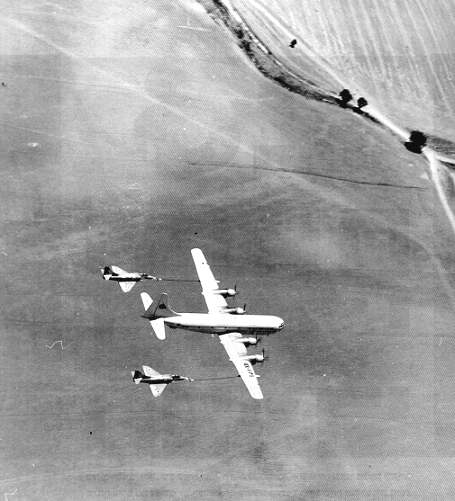
Boeing Stratocruiser at the IAF Museum
In 1941-2 Boeing designed the Model 367, a transport version of its B-29 Superfortress bomber. Boeing received a US Army Air Force order for three XC-97s in December 1942 but the urgent need to concentrate on combat aircraft inevitably slowed the type's developement and the first flight did not take place until November 15th 1944. Changes from the bomber were mainly confined to the fuselage, with a much larger upper lobe which introduced the double-double cross-section seen on most of today's airliners. The type enjoyed massive military success, most notably in the inflight refuelling role, with 888 military C-97s built by the end of production on July 18th 1956. Boeing had also shown a great interest in the civilian airliner market but initialy failed to secure orders for the civilian Model 377. In late 1945 Boeing president Bill Allen decided to build 50 Model 377s at company risk and in June 1946 Pan Am finally signed for the first 20 aircraft, much to Boeing's relief. Among the type's other civilian operators were United Airlines, BOAC and Northwest Airlines.

Boeing Stratocruiser at the IAF Museum
The early 1960s saw the IAF looking for a new long range transport aircraft to augment its C-47s and Nord Noratlases. When the US Administration however refused to allow Israel to purchase the Lockheed C-130 Hercules, Israel Aircraft Industries (IAI) stepped in and offered the IAF its expertise in converting civilian aircraft to military standards. IAI had put its hands on a Boeing Stratocruiser, had extensively flight tested it and was now offering the type to the IAF. Despite the objection of the IAF commander of the time, Ezer Weizmann, fearing the introduction of an such elderly aircraft type into the IAF, The Israeli ministry of defence nonetheless pushed forward the proposed deal.
In 1962 Five Boeing 377s were purchased by IAI from Pan Am and underwent an extenesive overhaul before their introduction into the IAF. The aircraft were converted to military cargo configuration with side clamshell doors and a military style tail that swung open (2 examples) or rear clamshell doors (3 examples). The aircraft entered service with the IAF on June 1st 1964, where the type was known as the "Anak" (giant). The Stratocruisers served with the 120th "International" squadron out of Ben Gurion International Airport. Eight more KC-97Gs and a KC-97F were obtained from USAF surplus in the following years, and these joined the 120th squadron as well, after removal of their inflight refuelling capability. The Stratocruisers were used for cargo and passenger transportation, parachuting, crew training, experimentation, photo reconnaissance and more.
The aircraft's early years in service saw a lot of flying abroad, especially before the 1967 Six Days War when the Stratocruisers often flew to France, Israel's major arms supplier at the time. In 1966 FX-FPY "Masada" carried Israeli Prime Minister Levy Eshkol on his historic tour of African states. This aircraft today resides at the IAF Museum at Hatzerim, housing a display about the beginning of aviation in Palestine (picture above). During the Six Days War the Stratocruisers flew cargo missions in support of Israel's advancing ground forces, using the rear clamshell doors for paradrops on at least one occasion. Following Israel's conquest of the Sinai Desert the Stratocruisers routinely flew troops and equipment in and out of IAF bases in the Sinai Peninsula. These flights continued during the War of Attrition and the Yom-Kippur War, when C-97s also flew into Faid, an Egyptian AFB on the west bank of the Suez Canal captured during the IDF incursion into mainland Egypt.
The arrival of the A-4 Skyhawk in the IAF in September 1967 prompted the conversion of at least three Stratocruisers back into tankers with a flying boom and underwing refuelling pods (picture below). Two aircraft were also converted for use in the Electronic Warfare role. When Arab air defences became too dangerous for direct reconnaissance overflights during the late 1960s and early 1970s, the IAF introduced oblique aerial photography by modifying Stratocruisers to carry exceptionaly long focal-length lens cameras. One converted KC-97G (4X-FPR) was downed by a pair of Egpytian SA-2s on September 17th 1971. Flying 23km within Israeli territory, at 30,000ft, the aircraft was photographing the Egyptian air defence array when it was hit and crashed in the Sinai, killing seven of the eight crew members.

Another Stratocruiser was lost on November 11th 1970 at Ben Gurion Airport during a nocturnal IAF exercise. A cargo TWA Boeing 707 on its takeoff run collided with a KC-97G which had been rolling with its navigation lights turned off. Two crew members were killed and two more injured.
The Stratocruisers were taken out of commission in April 1978. Two examples still survive in Israel, both at the IAF Museum, although only one is on display ("Masada") while another is awaiting restoration off the display area.
 back to the IDF/AF page
back to the IDF/AF page